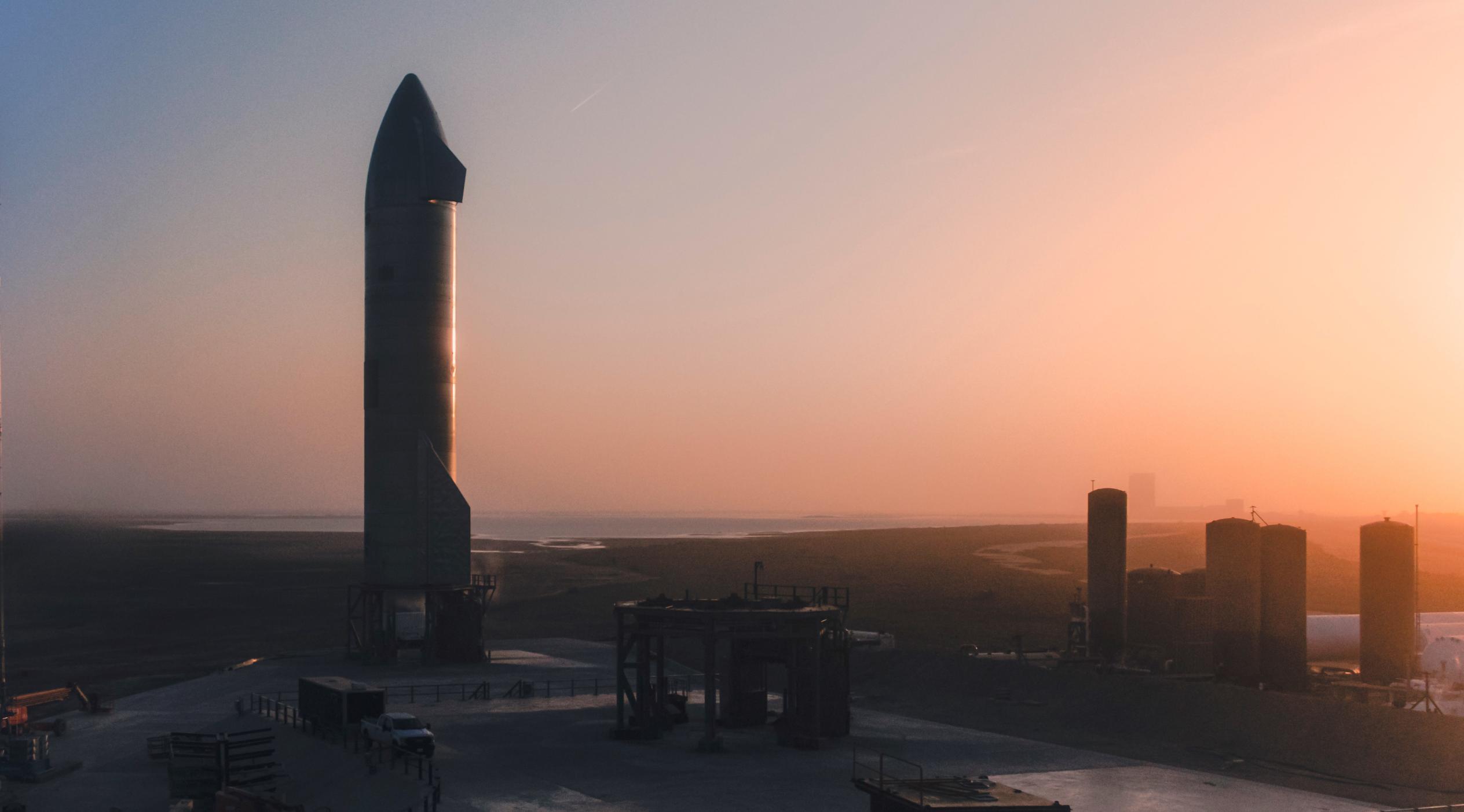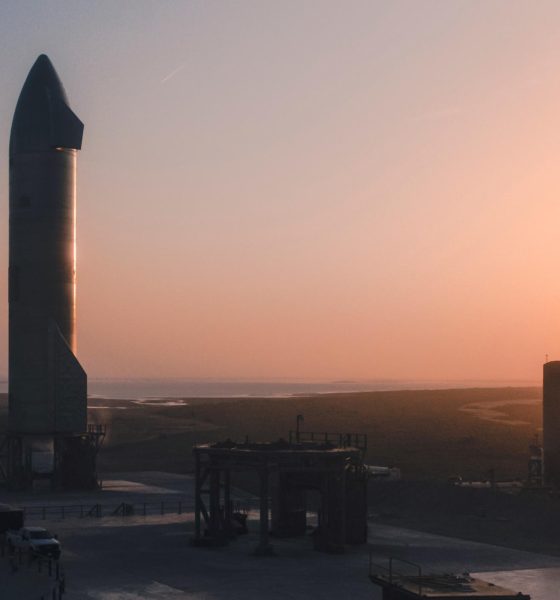

News
[Update: Scrubbed] SpaceX Starship to attempt same-day static fire and launch
Update: Starship SN11 did manage a timely static fire around 8am CDT but after hours of work, SpaceX appears to have scrubbed a Friday, March 26th launch attempt.
SpaceX’s website has yet to be updated and Friday’s FAA TFR is still active but a road closure meant to last until 7:30 pm CDT to cover the static fire and launch was retracted after the highway was reopened around 2:45 pm. It’s unclear what caused the scrub but weather or technical issues from the static fire are two likely candidates. SpaceX still has TFRs active on Saturday and Sunday, but the company hasn’t tested or flown on a weekend in months.
Lacking only an official confirmation, SpaceX appears to be readying the fourth full-size Starship prototype to attempt a Raptor static fire test and launch on the same day.
That hopeful day in question happens to be today – Friday, March 26th. If all goes according to plan, Starship serial number SN11 will fire up its three Raptors, verifying their health after an engine was apparently swapped out on Wednesday. Possibly just an hour or two later, after detanking and retanking liquid oxygen and methane propellant, the Starship prototype could lift off on SpaceX’s fourth high-altitude test flight.
Late on March 24th, SpaceX rolled Raptor engine SN46 from its Boca Chica factory to the launch pad, where Starship SN11 is installed on one of two suborbital launch mounts. The engine move and subsequent installation came as a surprise, as nobody managed to catch an implied Starship SN11 engine removal in the two or three days prior (extremely thick fog being the likeliest cause).
The implied issue with the Raptor that was removed is likely to blame for a several-day launch delay that followed Starship’s seemingly successful Monday static fire. After that test, SN11’s launch was initially scheduled as early as Tuesday or Wednesday, only to slip day by day as the week proceeded. SN11 first rolled to the launch pad on March 8th, just 18 days ago, so launch delays don’t come as a huge surprise given that the current factory-to-launch record for a three-engine Starship is 33 days, three static fires, and one engine swap.
If SN11 manages a same-day static fire and launch on March 26th, it will still crush that record by almost 50%. To an extent, the feat also isn’t unprecedented. On March 3rd, Starship SN10 aborted its first true launch attempt milliseconds after Raptor ignition when the rocket’s flight computer detected indications that they were producing too much thrust. Amazingly, instead of scrubbing the launch attempt, SpaceX loosened Starship SN10’s thrust limit parameters and tried again, successfully lifting off just three hours after the abort.
Despite the abort and immediate hands-free recycle, Starship SN10 subsequently became the first prototype of its kind to launch to 10 km (6.2 mi), free-fall back to earth, and land in one piece. Minutes later, a fire and harder landing than expected conspired to make SN10 explode, but the test flight was arguably still a massive success. Simultaneously, the flight indicated that Starships are technically capable of successfully flying hours after a post-ignition launch abort, demonstrating an extraordinary level of robustness for clustered high-performance rocket engines.
As such, while it’s probably reasonable to assume that Starship SN11 wont launch today, SN10 proved that there is nonzero chance of a static fire and launch hours apart. Additionally, given just how close SN10 go to unequivocal success (i.e. a soft and survivable landing), Starship SN11 has the best chance yet at at launching, landing, and making it through the ordeal without exploding.
Starship SN11’s third static fire and first launch attempt are both currently scheduled sometime between 7am and 7:30pm CDT (UTC-5). Stay tuned for updates as we wait for SpaceX’s official confirmation and an evacuation notice of Boca Chica Village residents.

Elon Musk
Elon Musk’s X will start using a Tesla-like software update strategy
The initiative seems designed to accelerate updates to the social media platform, while maintaining maximum transparency.

Elon Musk’s social media platform X will adopt a Tesla-esque approach to software updates for its algorithm.
The initiative seems designed to accelerate updates to the social media platform, while maintaining maximum transparency.
X’s updates to its updates
As per Musk in a post on X, the social media company will be making a new algorithm to determine what organic and advertising posts are recommended to users. These updates would then be repeated every four weeks.
“We will make the new 𝕏 algorithm, including all code used to determine what organic and advertising posts are recommended to users, open source in 7 days. This will be repeated every 4 weeks, with comprehensive developer notes, to help you understand what changed,” Musk wrote in his post.
The initiative somewhat mirrors Tesla’s over-the-air update model, where vehicle software is regularly refined and pushed to users with detailed release notes. This should allow users to better understand the details of X’s every update and foster a healthy feedback loop for the social media platform.
xAI and X
X, formerly Twitter, has been acquired by Elon Musk’s artificial intelligence startup, xAI last year. Since then, xAI has seen a rapid rise in valuation. Following the company’s the company’s upsized $20 billion Series E funding round, estimates now suggest that xAI is worth tens about $230 to $235 billion. That’s several times larger than Tesla when Elon Musk received his controversial 2018 CEO Performance Award.
As per xAI, the Series E funding round attracted a diverse group of investors, including Valor Equity Partners, Stepstone Group, Fidelity Management & Research Company, Qatar Investment Authority, MGX, and Baron Capital Group, among others. Strategic partners NVIDIA and Cisco Investments also continued support for building the world’s largest GPU clusters.
News
Tesla FSD Supervised wins MotorTrend’s Best Driver Assistance Award
The decision marks a notable reversal for the publication from prior years, with judges citing major real-world improvements that pushed Tesla’s latest FSD software ahead of every competing ADAS system.

Tesla’s Full Self-Driving (Supervised) system has been named the best driver-assistance technology on the market, earning top honors at the 2026 MotorTrend Best Tech Awards.
The decision marks a notable reversal for the publication from prior years, with judges citing major real-world improvements that pushed Tesla’s latest FSD software ahead of every competing ADAS system. And it wasn’t even close.
MotorTrend reverses course
MotorTrend awarded Tesla FSD (Supervised) its 2026 Best Tech Driver Assistance title after extensive testing of the latest v14 software. The publication acknowledged that it had previously criticized earlier versions of FSD for erratic behavior and near-miss incidents, ultimately favoring rivals such as GM’s Super Cruise in earlier evaluations.
According to MotorTrend, the newest iteration of FSD resolved many of those shortcomings. Testers said v14 showed far smoother behavior in complex urban scenarios, including unprotected left turns, traffic circles, emergency vehicles, and dense city streets. While the system still requires constant driver supervision, judges concluded that no other advanced driver-assistance system currently matches its breadth of capability.
Unlike rival systems that rely on combinations of cameras, radar, lidar, and mapped highways, Tesla’s FSD operates using a camera-only approach and is capable of driving on city streets, rural roads, and freeways. MotorTrend stated that pure utility, the ability to handle nearly all road types, ultimately separated FSD from competitors like Ford BlueCruise, GM Super Cruise, and BMW’s Highway Assistant.
High cost and high capability
MotorTrend also addressed FSD’s pricing, which remains significantly higher than rival systems. Tesla currently charges $8,000 for a one-time purchase or $99 per month for a subscription, compared with far lower upfront and subscription costs from other automakers. The publication noted that the premium is justified given FSD’s unmatched scope and continuous software evolution.
Safety remained a central focus of the evaluation. While testers reported collision-free operation over thousands of miles, they noted ongoing concerns around FSD’s configurable driving modes, including options that allow aggressive driving and speeds beyond posted limits. MotorTrend emphasized that, like all Level 2 systems, FSD still depends on a fully attentive human driver at all times.
Despite those caveats, the publication concluded that Tesla’s rapid software progress fundamentally reshaped the competitive landscape. For drivers seeking the most capable hands-on driver-assistance system available today, MotorTrend concluded Tesla FSD (Supervised) now stands alone at the top.
News
Elon Musk’s Grokipedia surges to 5.6M articles, almost 79% of English Wikipedia
The explosive growth marks a major milestone for the AI-powered online encyclopedia, which was launched by Elon Musk’s xAI just months ago.

Elon Musk’s Grokipedia has grown to an impressive 5,615,201 articles as of today, closing in on 79% of the English Wikipedia’s current total of 7,119,376 articles.
The explosive growth marks a major milestone for the AI-powered online encyclopedia, which was launched by Elon Musk’s xAI just months ago. Needless to say, it would only be a matter of time before Grokipedia exceeds English Wikipedia in sheer volume.
Grokipedia’s rapid growth
xAI’s vision for Grokipedia emphasizes neutrality, while Grok’s reasoning capabilities allow for fast drafting and fact-checking. When Elon Musk announced the initiative in late September 2025, he noted that Grokipedia would be an improvement to Wikipedia because it would be designed to avoid bias.
At the time, Musk noted that Grokipedia “is a necessary step towards the xAI goal of understanding the Universe.”
Grokipedia was launched in late October, and while xAI was careful to list it only as Version 0.1 at the time, the online encyclopedia immediately earned praise. Wikipedia co-founder Larry Sanger highlighted the project’s innovative approach, noting how it leverages AI to fill knowledge gaps and enable rapid updates. Netizens also observed how Grokipedia tends to present articles in a more objective manner compared to Wikipedia, which is edited by humans.
Elon Musk’s ambitious plans
With 5,615,201 total articles, Grokipedia has now grown to almost 79% of English Wikipedia’s article base. This is incredibly quick, though Grokipedia remains text-only for now. xAI, for its part, has now updated the online encyclopedia’s iteration to v0.2.
Elon Musk has shared bold ideas for Grokipedia, including sending a record of the entire knowledge base to space as part of xAI’s mission to preserve and expand human understanding. At some point, Musk stated that Grokipedia will be renamed to Encyclopedia Galactica, and it will be sent to the cosmos.
“When Grokipedia is good enough (long way to go), we will change the name to Encyclopedia Galactica. It will be an open source distillation of all knowledge, including audio, images and video. Join xAI to help build the sci-fi version of the Library of Alexandria!” Musk wrote, adding in a later post that “Copies will be etched in stone and sent to the Moon, Mars and beyond. This time, it will not be lost.”








